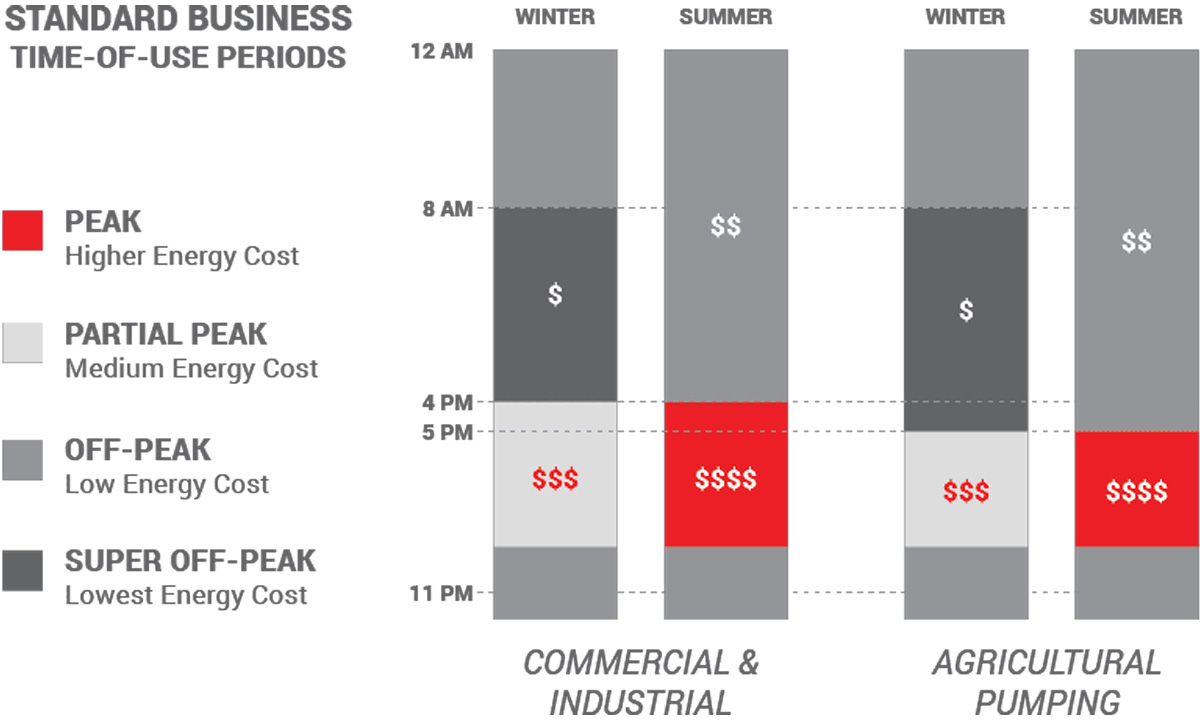Commercial and Industrial (C&I) energy bills are based on various components that cumulatively determine the total cost of purchasing energy. To effectively manage and potentially reduce energy costs, it's essential to understand some of the key aspects of C&I energy bills. We will discuss common terms and highlight how energy storage systems can support strategies for Time of Use (TOU) and Demand Response (DR).
Demand charges
A demand charge on an electricity bill is a fee based on the highest level of electricity usage within a specific period, typically measured in kilowatts ($/kW). It is separate from the standard usage charges and reflects the maximum amount of power drawn from the grid during peak times. Essentially, it accounts for the cost of ensuring the capacity to meet a consumer’s highest electricity demand, encouraging consumers to manage their peak power usage to minimize this additional fee.
Rate schedules
These are structured frameworks for determining electricity costs for C&I clients. Utilities offer various schedules, which significantly impact costs. Understanding your business's specific rate schedule is crucial, as it influences demand and energy charges.
Energy charges
These charges are based on actual electricity consumption (measured in kWh). C&I clients might be billed using time-of-use rates, meaning costs vary based on time of day, with off-peak hours generally being cheaper.
Off-peak electricity hours are times when electricity demand and usage are at their lowest. This typically corresponds with lower electricity prices. These hours can vary depending on your location and utility company, but they are often aligned with the times when most people are out of the house for work or school. Generally, for many areas, off-peak hours are late night to early morning, often from 9 or 10 P.M. until 6 or 7 A.M. Midday may also see off-peak rates, especially in regions where solar energy production is high.
To determine the specific off-peak hours for your region, it's best to consult your local utility company's website or customer service. They will provide the most accurate and current information relevant to your area. Keep in mind that these off-peak hours typically apply to weekdays, as energy usage patterns can be quite different on weekends.
Power factor
The metric called Power Factor indicates the efficiency of electrical power conversion into useful work output. A low power factor can lead to penalties and higher costs for C&I clients, who can improve it by installing power factor correction equipment. Equipment that is compatible with varying voltage applications comes with fixed and automatic switched capacitors that will raise the facility's power factor to meet utility requirements and remove high-priced utility charges.
We find that electric utility costs are influenced by a site's load magnitude and shape and its utility bill structure, with rate structures growing increasingly complex. For instance, a site's rate is typically based on delivered voltage, and smaller sites often receive lower voltage. In deregulated states, businesses can choose their electric supply provider, which can affect the billing structure and overall costs and come with its own risks and rewards.
By comprehensively understanding these components, C&I clients can make informed decisions to optimize their electricity costs, leveraging their knowledge of rate schedules, demand patterns, and power factor efficiencies.
Understanding time-of-use rates
What are TOU rates?
Time-of-use rates are utility rate structures designed to align electricity costs with the actual cost of generating electricity. They adjust the electricity rate throughout the day, typically lower when the cost of generation and demand is low (like at night) and higher during peak demand times (like a hot summer afternoon).

Source: Revel. Sample of Southern California Edison (SCE) Customer’s TOU rate schedule.To find out your exact TOU rates contact your Utility Company.
Understanding and leveraging demand response
What is demand response?
Demand response is a strategy that enables ratepayers to adjust their electricity usage based on the supply-demand conditions of the grid. It plays a crucial role in maintaining grid stability.

Source: Statista 2023
Mechanisms of demand response
Price-based programs (implicit demand response)
These programs use price signals and tariffs to encourage consumers to shift their consumption to when electricity is cheaper or less in demand.
Incentive-based programs (explicit demand response)
These involve direct payments to consumers who shift their demand as part of a demand-side response program.
Why is demand response important?
Grid stability is enhanced through energy load shifting, as it aids in preventing blackouts and power disruptions by effectively managing peak demand periods. This practice also contributes to cost reduction, as it encourages shifting energy usage to off-peak hours, resulting in lower electricity costs. Furthermore, energy load shifting increases efficiency by optimizing existing infrastructure, which extends the need for new power plants and transmission upgrades. Additionally, it encourages the integration of renewable energy sources and energy storage.
Strategies for saving and optimizing on-site energy usage
- Utilize energy-efficient products and equipment. Retrofit to LEDs from traditional incandescent and HID lamps to reduce energy consumption and heat emissions.
- Use occupancy/vacancy sensing controls and time-scheduled dimming for optimized lighting.
- Implement regular and proactive maintenance using condition-monitoring sensors. Employ predictive maintenance tools for timely equipment repairs.
- Monitor and control harmonic distortion in electrical systems regularly.
- Detect and repair air compressor leaks using advanced detection tools.
- Implement waste heat recovery systems to reuse excess heat from processes for cogeneration, aiding in energy savings and pollution reduction.
- Shift non-critical operations to times when energy demand and costs are lower.
- Balance energy usage across different times to avoid peak demand charges.
- Implementing energy storage systems to shift loads during peak hours.
Energy storage systems for demand response
Leveraging battery storage for C&I facility demand response is a strategic approach to enhancing control over facility power, especially when paired with renewable energy sources such as wind and solar. This strategy involves using storage systems to charge during low demand and emit power during high demand times. When coupled with renewable energy, it can increase this independence from the grid, especially during peak hours.
Battery storage is increasingly becoming a key player in the energy management strategies of commercial buildings, especially within the context of demand response programs. These programs enable businesses to adjust their electricity usage in response to grid conditions, thereby contributing significantly to grid stability and efficiency.
Commercial and Industrial battery storage systems are particularly advantageous in regions prone to frequent power outages, serving as a reliable safeguard against disruptions in electricity supply.
The ROI for such battery storage solutions is highly dependent on specific factors related to the facility. These factors include the unique energy needs of the facility, its geographical location, and the availability of rebates and incentive programs in the area. Locations with more frequent power disruptions can benefit significantly from the resilience offered by battery storage, ensuring continuous operations and minimizing potential losses due to power outages.

The economic feasibility and attractiveness of investing in energy storage are enhanced by current incentive programs and rebates, which can substantially offset the initial costs and accelerate the payback period. For example, California's Self Generation Incentive Program (SGIP) offers rebates for about 20% of equipment and installation for C&I customers. For facilities considering C&I battery storage, a thorough assessment of these factors is crucial to determining such an investment's viability and potential financial benefits.

Request a Commercial Consultation
Talk with a Briggs & Stratton energy expert by clicking the button below and provide basic information about your upoming project!



